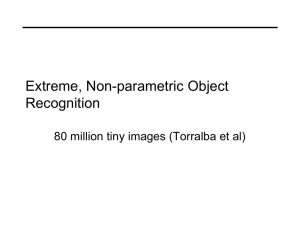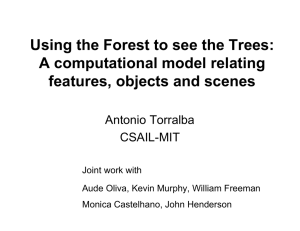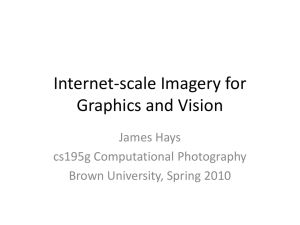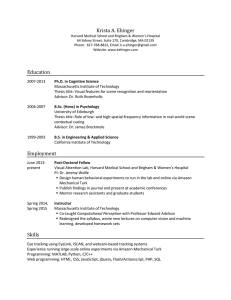Statistics of Natural Image Categories Jonathan Huang () 1/30/2006
advertisement
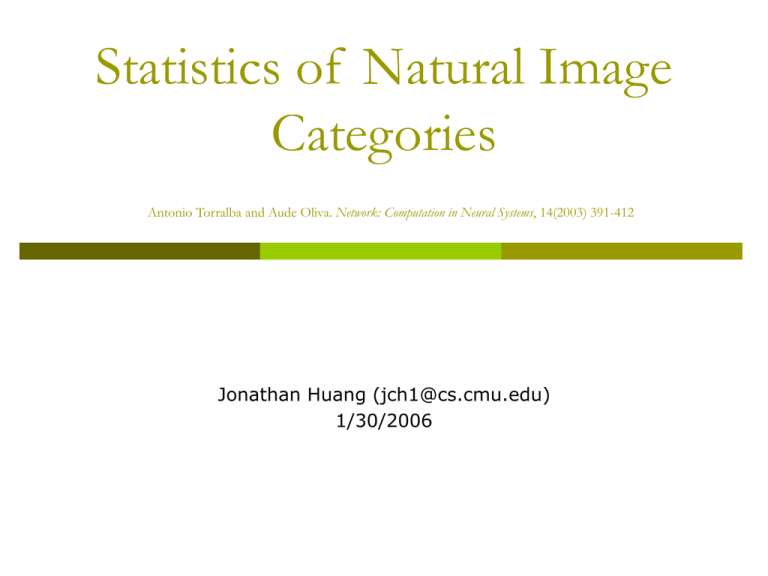
Statistics of Natural Image Categories Antonio Torralba and Aude Oliva. Network: Computation in Neural Systems, 14(2003) 391-412 Jonathan Huang (jch1@cs.cmu.edu) 1/30/2006 Spatial Image Signatures Averaged pictures of categories of objects, scenes and objects in scenes, computed with 100 exemplars or more per category. Exemplars were chosen to have the same basic level and viewpoint in regard to an observer. The group objects in scenes (third row) represent examples of the averaged peripheral information around an object centered in the image. Caltech 101 Object Categories: Airplanes Brain Brontosaurus Chandelier Garfield Kangaroo Octopus Trilobyte Etc… By Antonio Torralba 100 Special Moments (and Conan) Conan O’Brien Newlyweds Little Leaguer By Jason Salavon Power Spectra of Natural Images Fourier Transform: Magnitude Spectrum: Spectral Signature (for a set of images S): “Demo” Computing the Spectrum (Matlab): Ifft = abs(fftshift(fft2(I,w,h))); Visualization: imshow(log(Ifft)/max(max(log(Ifft)))); colormap(cool); FFT(Beach) FFT(Pittsburgh) 1/f Spectra Natural Image Spectra follow a power law! As() is called the Amplitude Scaling Factor 2-() is the Frequency Exponent. clusters around 0 for natural images. Any guesses on why this law holds? Main Idea of Torralba/Oliva Papers “Statistics of Natural Images vary as a function of the interaction between the observer and the world”! Some examples Spectral Signatures Why are Fields, Beaches and Coasts less isotropic than other natural environments? Scene Scale “The point of view that any given observer adopts on a specific scene is constrained by the volume of the scene.” How does the amount of clutter vary against scene scale in manmade environments? In natural environments? PCA on Natural Images Top Row: PCA on images Bottom Row: PCA on power spectra Openness/Naturalness Projection of images onto the second and third principle components. SPC2 corresponds to “Openness” and SPC3 corresponds to “Naturalness” Spatially Localized Statistics Windowed FFT Top Row: Man-made environments Bottom Row: Natural environments Image statistics become non-stationary as scene scale increases. What do Images Statistics say about Depth? V: Vertical H: Horizontal O: Oblique Comparing Localized Spectral Signatures and Depth With increasing depth comes: An increase in global roughness for man-made structures A decrease in global roughness for natural structures Nonuniformity in spatially localized spectral signatures Examples (man-made) Examples (Natural) An Algorithm First use PCA to reduce dimension Goal: For a vector of features v, estimate Since the man-made and natural cases should be treated separately, we model f(v|art) and f(v|nat) as Gaussians. The joint distribution is modeled as a weighted sum of Gaussians: where Model Estimation Expectation-Maximization E-step: Compute posterior probabilities of the clusters given observed data. M-step: Update cluster parameters, weighting training data by the posterior probabilities from the E-step. Read Torralba and Oliva: Depth Estimation, IEEE PAMI 2002 for the update equations. They do not all fit on one slide... Some Results f(D|category) Distribution of Scene Categories as a function of mean depth. Application: Scale Selection Context in Images Question: How can these small people possibly affect the image statistics in any significant way?? Object Detection Thank You References Torralba and Oliva, Statistics of Natural Image Categories. Network: Computation in Neural Systems 14 (2003) 391-412. Torralba and Oliva, Depth Estimation from Image Structure. IEEE PAMI Vol 14, No. 9 (2002). Oliva and Torralba, Modeling the Shape of the Scene: A Holistic Representation of the Spatial Envelope. IJCV 42(3), 145-175 (2001). Srivastava, Lee, Simoncelli, Zhu, On Advances in Statistical Modeling of Natural Images. JMIV 18:17-33 (2003) Mumford, Pattern Theory: the Mathematics of Perception. ICM 2002. Vol III. 1-3
